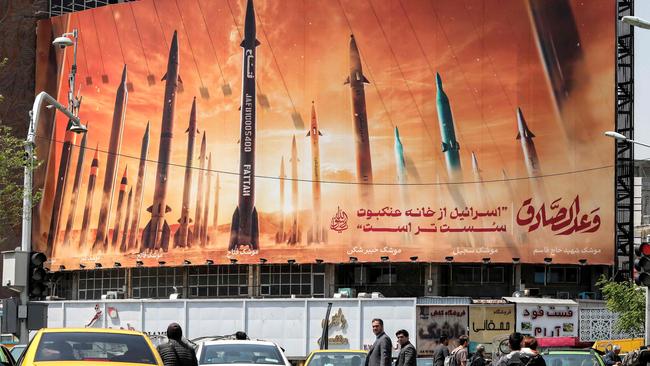Australia’s interest rates unlikely to be cut in 2024
Aussies are desperately waiting for cost of living relief via interest rate cuts but new issues have emerged which could stop it happening this year.

Interest Rates
Don't miss out on the headlines from Interest Rates. Followed categories will be added to My News.
For Australians who have been smashed by skyrocketing interest rates — which have added thousands of dollars to their yearly mortgage repayments — a desperate wait for relief could be even further way.
Experts had predicted rates would be slashed in Australia in the second half of this year but the latest escalation of hostilities in the Middle East poses new risks to global inflation, while the US also reported hotter inflation than expected in March.
Interest rates are currently at 4.35 per cent in Australia, soaring from 0.1 per cent in the space of 15 months.
Iran launched an attack on Israel unlike anything the world has seen with more than 300 munitions fired on Saturday – and surprisingly this could impact Australia’s interest rates.

Alongside the chilling humanitarian costs of the attack, the latest strike could also spell bad news for tackling global inflation, according to Betashares chief economist David Bassanese.
Iran is one of the world’s leading oil producers and any disruption to its capacity to supply global markets could see oil prices rise further, pushing up global inflation from still overly high levels — making it difficult for banks around the world to lower rates, he explained.
“Despite lingering trade sanctions, Iranian oil exports have lifted strongly over the past few years — especially to China — with the United States seemingly passively accepting this as a means to keep downward pressure on world oil prices and US inflation,” he said.
“But if hostilities with Israel escalate, the United States along with its allies, may come under renewed pressure to strengthen sanctions once again.
“In the case of Australia, petrol prices account for just under 4 per cent of the consumer price index directly. Higher oil prices would also have indirect inflation effects as it would raise costs for a range of businesses.
“A strong and sustained rebound in oil prices would not just further hurt real household incomes – weakening consumer spending further – but also raise inflation and make it difficult for the Reserve Bank to deliver interest rate cuts later this year.”

In the US rates are currently sitting at 5.37 per cent – the highest in 23 years – and now some economists have dropped their predictions of cuts by June. Instead experts are warning there will be no relief before Christmas after March inflation in the US accelerated from 3.2 per cent to 3.5 per cent.
Economists at Bank of America and RBC slashed their expectations for an easing of interest rates and chillingly some even warned that there could be more rate rises ahead.
The US Fed is the world’s most powerful central bank and often leads global rate cutting agenda.
Bendigo Bank chief economist, David Robertson, agreed others usually follow the Fed and said the Reserve Bank of Australia (RBA) is around six months behind most other central banks – which means rate cuts could be delayed until 2025.

Other factors that could rule out the RBA slashing rates include a slower fall in inflation and a rise in employment.
“Another challenge for those forecasting early RBA cuts is persistently high property prices, with the latest CoreLogic data showing another 0.6 per cent rise nationally in March,” he added.
“While these findings primarily reflect a lack of new dwellings keeping pace with population growth, it still adds to inflationary risks, so our long-held view that RBA rate cuts are most likely to commence in 2025 remains unchanged.”
Bond traders in Australia have also ruled out any rate relief by the RBA this year and don’t anticipate cuts until February 2025.
However, investment company Jamieson Coote Bonds’ chief investment officer Charlie Jamieson, said other countries could break away from the US situation.
He said given the low domestic growth and better-behaved inflation outcomes in other countries, they believe the time is approaching for many Western economies to embark on interest rate cutting cycles – with or without the US Federal Reserve.

Mr Jamieson predicted a player closer to home could lead the world by cutting rates first – New Zealand.
“The Reserve Bank of New Zealand commenced its rate-hiking cycle six months ahead of the Reserve Bank of Australia, also reaching its cash rate peak of 5.5 per cent six months ahead of the RBA’s pea,” he said.
“Over that rate hiking cycle, the New Zealand economy has spluttered to a halt, with negative growth recorded in five of the last eight quarters, along with three of the last four quarters experiencing negative GDP outcomes, with the rate of economic deceleration increasing.
“Given New Zealand’s six-month lead in the hiking cycle and associated economic weakness, we expect our own economy will continue to lose momentum over the balance of the year, bringing the RBA to the rate cutting table in the second half of 2024.”
Meanwhile, there are fears Iran’s planned strike against Israel could put the Middle East on the brink of wider conflict which will have broader implications for the global economy.

Mr Bassanese said remains to be seen whether Iran’s drone strike on Israel will be one-off retaliation for Israel’s strike in Syria, which killed a leading Iranian military commander, and how Israel will in turn respond.
“If a tit-for-tat escalation in hostilities can be avoided, the impact on oil prices could be limited,” he said.
“But further escalation which leads to a curtailment of Iranian oil exports, along with the tragic humanitarian consequences, would come at an unfortune time for global financial markets as it would frustrate hopes for lower inflation and interest rates in the coming months.”
Originally published as Australia’s interest rates unlikely to be cut in 2024





